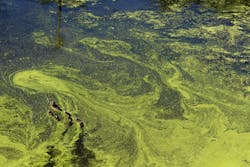UN Issues Report on Harmful Algae Blooms
Although thousands of microalgae species form the foundation of aquatic food chains, help control atmospheric CO2 levels, and produce roughly half of the world's oxygen, there are approximately 200 species that can produce potent toxins or cause harm through their sheer biomass, plus a similar number of non-toxic species that can harm fish gills, discolor ocean water, cause scums and foams, or deplete oxygen.
After seven years of analyzing nearly 10,000 harmful algal bloom (HAB) events over the course of three decades, a report will be published by the HAB Programme of the United Nations Educational, Scientific and Cultural Organization's (UNESCO) Intergovernmental Oceanographic Commission (IOC).
In the first-ever attempt at this scale to detect changes in the distribution, frequency, and intensity of HABs globally, over 100 scientists in 112 countries assisted in the synthesis and analysis of data gathered from 1985 to 2018.
The health and economic damages caused by harmful algae outlined by the authors include:
- Bioaccumulation of toxins in seafood (the most dominant HAB problem, broken down by both region and by algae species)
- Toxic or non-toxic microalgae blooms causing discolored water, scum, mucilage, or foam, harming tourism and/or fisheries
- Mass fish kills, including in aquaculture operations
- High biomass, causing closures of beaches or desalination plants
The work assesses the occurrence of toxin-producing and other harmful microalgae, and the status and probability of change in HAB frequencies, intensities, and range resulting from environmental changes at the local and global scale.
The study involved mining the global Harmful Algae Event Database (HAEDAT), consisting of 9,503 events with one or more impacts on human society, together with the Ocean Biodiversity Information System (OBIS), which contains 7 million microalgal records including 289,668 toxic algal species occurrences. HAEDAT and OBIS are both components of the IOC International Oceanographic Data and Information Exchange Programme (IODE).
Due to differences in the levels of monitoring worldwide, trends within the HAEDAT database were examined regionally and corrected for sampling effort using OBIS phytoplankton species records as a proxy.
The work creates the first-ever baseline to facilitate future tracking and detection of changes in the world's HAB problems, and to help manage the problems in the future.
As part of the HAB program, the IOC also maintains an IOC-UNESCO Taxonomic Reference List of Harmful Micro Algae, "with the aim of providing an agreed reference list of harmful algal species, including correct citation of the author(s), date of valid publication, and a list of synonyms."
"The most frequently asked questions about Harmful Algal Blooms (HABs) are if they are increasing and expanding, and what are the mechanisms behind observed trends," the authors say.
"Indeed a global expansion of HABs and its causes have long been debated. Eutrophication, human-mediated introduction of alien harmful species, climatic variability, and aquaculture have all been mentioned as possible causes of an expansion and intensification of HABs. Our research sheds an authoritative light on the problem and will help guide responses to it for decades to come."
The IOC Intergovernmental Panel on HABs began the Global HAB Status Report in 2013.
The work is linked with the International Panel on Climate Change (IPCC) reporting mechanism, which increasingly is focusing on the biological impacts of climate change.
IOC UNESCO project partners include the International Atomic Energy Agency (IAEA), the International Council for Exploration of the Sea (ICES), the North Pacific Marine Science Organization (PICES), and the International Society for the Study of Harmful Algae (ISSHA). The initiative receives financial support from the Government of Flanders/FUST-DIPS.


